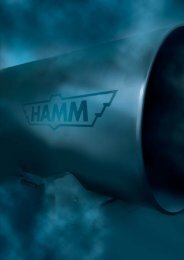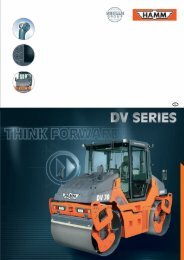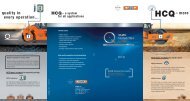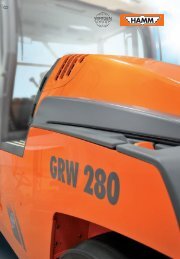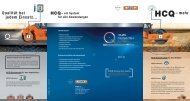Flyer Oscillation - Hamm AG
Flyer Oscillation - Hamm AG
Flyer Oscillation - Hamm AG
You also want an ePaper? Increase the reach of your titles
YUMPU automatically turns print PDFs into web optimized ePapers that Google loves.
More than 25 years of success<br />
and experience with <strong>Oscillation</strong>!<br />
Vibration –<br />
<strong>Oscillation</strong>:<br />
100%<br />
95%<br />
90%<br />
85%<br />
Benefits of <strong>Oscillation</strong><br />
cp–2.com<br />
O S C I L L A T I O N<br />
Vibration<br />
A rotating eccentric mass provides<br />
fast up-and-down movement of the<br />
roller drum.<br />
<strong>Oscillation</strong><br />
Two eccentric masses rotate in sync.<br />
This produces a rapidly changing<br />
forward/reverse, rocking movement<br />
of the roller drum.<br />
• The ultimate in compaction performance<br />
• You cannot over-compact – no grain crushing<br />
• No chatter marks for perfect smoothness<br />
• No vibration to sensitive surroundings or the machine<br />
• No damage to cold joints<br />
• Able to work effectively and safely on cooler mixes<br />
• Fewer passes required<br />
• Uniform density<br />
• Self adjusting<br />
<strong>Oscillation</strong> is the most<br />
intelligent compactor!<br />
© HAMM - 08.11 - 2200179 E<br />
<strong>Oscillation</strong>:<br />
The proven technology!<br />
Thousands of <strong>Oscillation</strong> compactors<br />
in use around the globe.<br />
HAMM <strong>AG</strong><br />
<strong>Hamm</strong>strasse 1<br />
D-95643 Tirschenreuth<br />
Tel +49 9631/ 80-0<br />
Fax +49 9631/ 80-111<br />
www.hamm.eu<br />
The compaction technology of the future<br />
Proven successful for decades<br />
Vibration<br />
The compaction energy is introduced vertically in the downward<br />
direction. Due to the up-and-down movement, the roller drum<br />
loses contact with the ground after each impact. For approximately<br />
50% of the time, it is not in contact with the ground.<br />
<strong>Oscillation</strong><br />
The compaction energy is introduced both vertically and horizontally<br />
to the front and rear of the drum. During the rocking<br />
movement, the roller drum does not lift off of the ground. On the<br />
contrary: It maintains continuous contact with material so that<br />
constant compaction occurs.
Faster compaction results<br />
Self adjusting compaction power<br />
More time for compaction<br />
Masters even the biggest challenges<br />
<strong>Oscillation</strong> makes it possible to achieve a faster increase in compaction.<br />
Why? During the forward and rearward movements of the drum, the<br />
compaction force is directed into the material, with the maximum<br />
utilization of the available compaction window.<br />
Advantages<br />
• Fewer passes needed compared to vibration<br />
• Faster increase in compaction<br />
The principle of <strong>Oscillation</strong> involves intelligent exploitation of the laws<br />
of physics. Depending on the rigidity of the material, the movement<br />
of the oscillating drum changes automatically: The more rigid the<br />
material, the less the movement. The system adapts automatically to<br />
the conditions without any presettings or preselection of the vibratory<br />
system.<br />
Advantages<br />
• Optimum compaction power at all times<br />
• No presettings No faulty settings<br />
Compaction work is possible only within a specifi c temperature<br />
range in relation to the asphalt type. To avoid displacing the material,<br />
vibrating rollers do not begin compaction until the right asphalt<br />
temperature is reached. In contrast, <strong>Oscillation</strong> rollers can begin<br />
effi cient dynamic compaction at high temperatures. As the asphalt<br />
begins to cool, vibration can result in grain crushing or destruction of<br />
the granular structure. On the other hand, <strong>Oscillation</strong> continuous to<br />
compact even at lower temperatures, without damage to the material.<br />
Advantages<br />
• With <strong>Oscillation</strong>, time frame for compaction is enlarged<br />
• More fl exibility<br />
• Excellent results in lower temperatures and/or windy conditions<br />
<strong>Oscillation</strong> rollers are your trump card when you need to compact thin<br />
layers or hard-to-handle materials, or when working on vibrationsensitive<br />
structures. In all of these cases, these rollers provide high<br />
compaction power combined with effi cient, dynamic compaction.<br />
When paving asphalt on bridges or installing thin layers, the asphalt<br />
cools off more quickly. Using the oscillation technique, this is not a<br />
problem since the rollers still deliver effi cient compaction at lower<br />
asphalt temperatures.<br />
<strong>Oscillation</strong> rollers can also be used to perform high-quality<br />
compaction of hard-to-handle modern mixes such as stone mastic<br />
asphalt.<br />
160° C / 320° F 140° C / 284° F 120° C / 248° F 100° C / 212° F 80° C / 176° F 60° C / 140° F<br />
VIBRATION<br />
C°/F<br />
Advantages<br />
• Also suitable for hard-to-compact types of asphalt<br />
• Ideal for dynamic compaction of thin-layer asphalts<br />
• Ideal for dynamic compaction on/or near sensitive structures<br />
Static<br />
OSCILLATION<br />
Static<br />
enlarged<br />
time frame with<br />
<strong>Oscillation</strong><br />
SOFT MATERIAL<br />
RIGID MATERIAL<br />
Continuous ground contact<br />
No over-compaction and<br />
no grain crushing<br />
Excellent compaction on joints<br />
Perfect smoothness<br />
Another benefi t: Compared to the vibration technique, only about<br />
15% of the vibratory affect is directed into the surrounding environment.<br />
This means that effi cient dynamic <strong>Oscillation</strong> compaction can<br />
easily be performed even in the vicinity of sensitive buildings or structures<br />
like bridges.<br />
In vibratory compaction, there is a risk of destroying the granular<br />
structure or grain crushing after a certain point is reached. However,<br />
this is not the case with <strong>Oscillation</strong>. The rigidity increases after each<br />
pass – without any undesired side-effects.<br />
At the joint between two driving lanes, e.g. when one lane is repaved,<br />
<strong>Oscillation</strong> avoids damage to the other lane, that is already fi nished,<br />
compacted and cooled down. Transverse passes are also no problem.<br />
The existing, cold road surface is not damaged or destroyed.<br />
Another result of <strong>Oscillation</strong> is a perfectly smooth surface fi nish.<br />
Due to the absence of any vertical impacts on<br />
the material, no bumps are formed.<br />
This means that roadways compacted with<br />
<strong>Oscillation</strong> result in a perfectly smooth fi nish.<br />
Advantages<br />
• Continuous dynamic compaction<br />
• Little vibratory affect of surroundings<br />
• Dynamic compaction even in sensitive areas and bridges<br />
• Ideal for dynamic compaction on bridges<br />
• Ideal for dynamic compaction over gas and water lines,<br />
near railroad tracks, etc.<br />
OSCILLATION<br />
VIBRATION<br />
Advantages<br />
• High degree of compaction<br />
• No over-compaction<br />
• Intact granular structure<br />
• No grain crushing<br />
• Achieving optimal density levels<br />
Advantages<br />
• Optimal, dynamic compaction<br />
all the way to the joint<br />
• No destruction of cold road surface<br />
• Long-lasting joint<br />
Advantages<br />
• Excellent ride ability<br />
• No chatter marks<br />
HOT<br />
COLD




